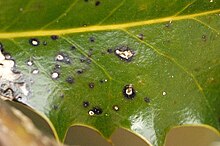| Coniothyrium | |
|---|---|

| |
| Coniothyrium ilicis | |
| Scientific classification | |
| Domain: | Eukaryota |
| Kingdom: | Fungi |
| Division: | Ascomycota |
| Class: | Dothideomycetes |
| Order: | Pleosporales |
| Family: | Coniothyriaceae |
| Genus: | Coniothyrium Corda (1840) |
| Type species | |
| Coniothyrium palmarum Corda (1840) | |
| Synonyms | |
Coniothyrium is a genus of fungi in the family Coniothyriaceae. The genus was circumscribed by Czech mycologist August Carl Joseph Corda in 1840. It was formerly placed in the Phaeosphaeriaceae family until 1983 when the family was established.
The genus are diverse geographically, and have a cosmopolitan distribution across the world.
The etymology of Coniothyrium is derived from New Latin, from coni- (from conus) and thyr- (from Greek thyreos meaning oblong shield, from thyra meaning door) and -ium (ending for a genus).
Coniothyrium palmarum is the type species of the genus Coniothyrium. It is characterised by ostiolate pycnidial (asexual fruiting body) conidiomata, annellidic conidiogenous cells, the absence of conidiophores, and brown, thick-walled, 0- or 1-septate, verrucose conidia. Coniothyrium is similar morphologically to some species in the genus Microsphaeropsis. However, Microsphaeropsis is characterised by the production of phialidic conidiogenous cells with periclinal thickening, and thin-walled, pale greenish brown conidia.
Species Coniothyrium glycines (R.B. Stewart) Verkley & Gruyter (2012) is known to cause red leaf blotch on Soyabean. While Coniothyrium fuckelii is also a known plant pathogen (causing stem canker,) that has also been known to cause infections in immunocompromised humans. Coniothyrium phyllachorae Maubl. (1904) with other fungus species such as Phyllachora maydis Maubl. and Monographella maydis Müller & Samuels are the causes of Latin America tar spot complex in places such as Guatemala, Mexico, Colombia, and El Salvador.
Species Coniothyrium ferrarisianum has been isolated from leaves of Daphne mucronata Royle in Iran, it was originally isolated from Acer pseudoplatanus L. in Italy in 1958, and it was later found on Vitis vinifera L. in Canada in 2017, as well as Prunus spp. in Germany in 2020, and also from Olea europaea L. in South Africa in 2020.
Species
The Species Fungorum list up to 450 species, in 2023), and the GBIF lists up to 499 species.
Main article: List of Coniothyrium speciesA selected few species are shown here.
- Coniothyrium abutilonis Khokhr. (1933)
- Coniothyrium acaciae Trotter (1916)
- Coniothyrium bambusae I. Miyake & Hara (1910)
- Coniothyrium batumense Siemaszko (1923)
- Coniothyrium caespitulosum Sacc. (1878)
- Coniothyrium carpaticum Petr. (1927)
- Coniothyrium celtidis-australis (Sacc.) Biga, Cif. & Bestagno (1959)
- Coniothyrium coffeae Zimm. (1902)
- Coniothyrium concentricum (Desm.) Sacc. (1878)
- Coniothyrium conicola Vestergr. (1902)
- Coniothyrium conorum Sacc. & Roum. (1882)
- Coniothyrium crepinianum Sacc. & Roum. (1884)
- Coniothyrium cydoniae Brunaud (1892)
- Coniothyrium dispersellum P. Karst. (1884)
- Coniothyrium dracaenae F. Stevens & Weedon (1925)
- Coniothyrium equiseti Lambotte & Fautrey (1896)
- Coniothyrium fluviatile Kabát & Bubák (1904)
- Coniothyrium fuckelii Sacc. (1876)
- Coniothyrium genistae (Roum.) Berl. & Voglino (1886)
- Coniothyrium glycines (R.B. Stewart) Verkley & Gruyter (2012)
- Coniothyrium henriquesii Thüm. (1879)
- Coniothyrium ilicis A.L. Sm. & Ramsb. (1917)
- Coniothyrium insitivum Sacc. (1878)
- Coniothyrium jasmini (Thüm.) Sacc. (1884)
- Coniothyrium juniperi Schwarzman (1968)
- Coniothyrium kallangurense B. Sutton & Alcorn (1975)
- Coniothyrium lavandulae Maire (1937)
- Coniothyrium leguminum (Rabenh.) Sacc. (1892)
- Coniothyrium marrubii Fairm. (1923)
- Coniothyrium obiones Jaap (1907)
- Coniothyrium oleae Pollacci (1911)
- Coniothyrium palmarum Corda (1840)
- Coniothyrium palmicola (Fr.) Starbäck (1894)
- Coniothyrium phlomidis Jaap (1916)
- Coniothyrium platani Sacc. (1878)
- Coniothyrium populina S. Ahmad (1971)
- Coniothyrium psammae Oudem. (1898)
- Coniothyrium pteridis A.L. Sm. (1916)
- Coniothyrium quercinum (Bonord.) Sacc. (1884)
- Coniothyrium rhododendri Henn. (1903)
- Coniothyrium rosarum Cooke & Harkn. (1882)
- Coniothyrium sarothamni (Thüm.) Sacc. (1884)
- Coniothyrium sphaerospermum Fuckel (1870)
- Coniothyrium stipae Săvul. & Sandu (1940)
- Coniothyrium tamaricis Oudem. (1901)
- Coniothyrium tenue Died. (1914)
- Coniothyrium trifolii Naumov (1913)
- Coniothyrium ulmeum P. Karst. (1884)
- Coniothyrium wernsdorffiae Laubert (1905)
- Coniothyrium yuccae Speg. (1902)
References
- "Synonymy: Coniothyrium Corda". Species Fungorum. CAB International. Retrieved 2014-01-18.
- Corda ACJ. (1840). Icones fungorum hucusque cognitorum (in Latin). Vol. 4. Prague: J.G. Calve.
- ^ de Gruyter, J.; Woudenberg, J.H.C.; Aveskamp, M.M.; Verkley, G.J.M.; Groenewald, J.Z.; Crous, P.W. (June 2013). "Redisposition of phoma-like anamorphs in Pleosporales". Studies in Mycology. 75: 1–36. doi:10.3114/sim0004. PMC 3713885.
- ^ "Coniothyrium Corda, 1840". www.gbif.org. Retrieved 28 July 2023.
- "Definition of CONIOTHYRIUM". www.merriam-webster.com. Retrieved 31 July 2023.
- Hartman, G.; Murithi, H.M. (22 May 2018). "Coniothyrium glycines (red leaf blotch)". CABI Compendium. doi:10.1079/cabicompendium.17687. Retrieved 29 July 2023.
- Kilian, M.; Steiner, U. (2003). "Disease / Bactericides and Fungicides". Encyclopedia of Rose Science.
- McManus, Dayna S. (2016). "A Worldwide Yearly Survey of New Data in Adverse Drug Reactions". Side Effects of Drugs Annual.
- Cairns, J.E.; Prasanna, B.M. (2012). "3.2.1 Plant diseases". Advances in Agronomy.
- Mehrabi-Koushki, Mehdi; Artand, Saeid (December 2022). "First report of Coniothyrium ferrarisianum from Iran". Bot. J. Iran. doi:10.22092/BOT.J.IRAN.2022.360285.1326.
- Bestagno-Biga, M.L.; Ciferri, R.; Bestagno, G. (1958). "Ordinamento artificiale delle specie del genere Coniothyrium". Sydowia. 12: 258–320.
- Ibrahim, A.; Sørensen, D.; Jenkins, H.A.; Ejim, L.; Capretta, A.; Sumarah, M.W. (2017). "Epoxynemanione A, nemanifuranones AeF, and nemanilactones AeC, from Nemania serpens, an endophytic fungus isolated from Riesling grapevines". Phytochemistry. 140: 16–26.
- Bien, S.; Damm, U. (2020). "Prunus trees in Germany, a hideout of unknown fungi". Mycological Progress. 19: 667–690.
- Spies, C.F.J.; Mostert, L.; Carlucci, A.; Moyo, P.; van Jaarsveld, W.J.; du Plessis, I.L.; van Dyk, M.; Halleen, F. (2020). "Dieback and decline pathogens of olive trees in South Africa". Persoonia - Molecular Phylogeny and Evolution of Fungi. 45: 196–220.
- "Species Fungorum - Search Page - Coniothyrium". www.speciesfungorum.org. Retrieved 28 July 2023.
| Taxon identifiers | |
|---|---|
| Coniothyrium |
|
This Pleosporales-related article is a stub. You can help Misplaced Pages by expanding it. |